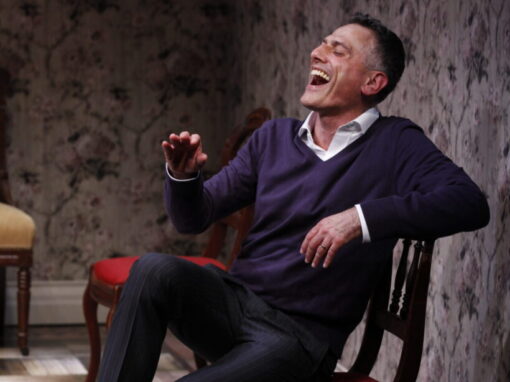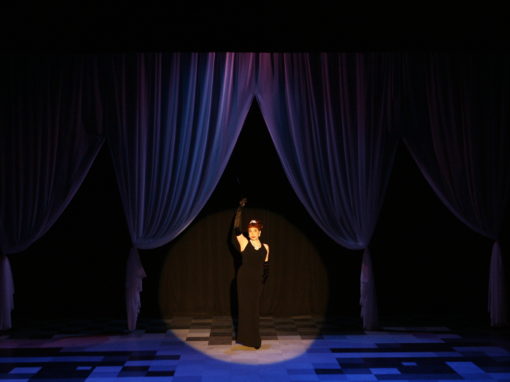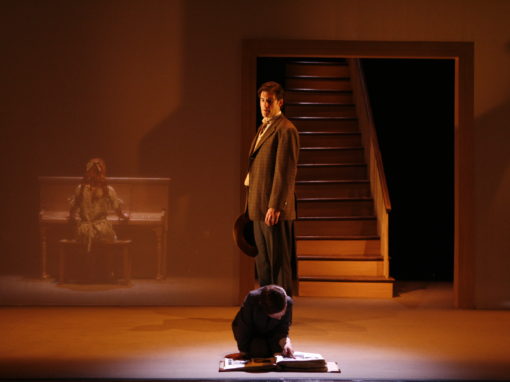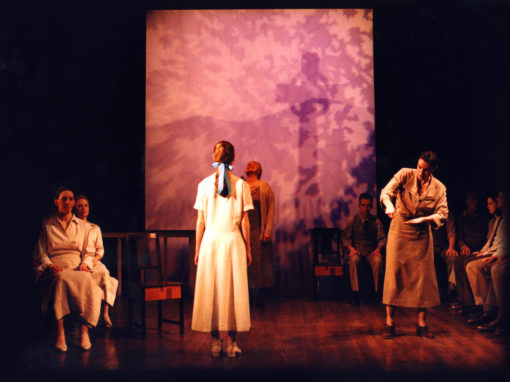To Tell the Truth // By Jack Cummings III
Artistic Director Jack Cummings III marvels at actor Phyllis Somerville’s magic trick of a performance in I REMEMBER MAMA.
On June 26, 2021, I had the honor of speaking at the memorial celebrating the life of actress Phyllis Somerville who had passed away the previous year on July 16, 2020. Unable to gather that summer of 2020, this was the first chance her friends and relatives were able to come together to remember her remarkable talent both as a human being and an artist.
I worked with Phyllis on our 2014 production of I REMEMBER MAMA, performed at The Gym at Judson Memorial Church—the same place as her memorial. The loving synchronicity of this was not lost on me. Given the ephemeral nature of theatre and theatre artists, I’d like to share what I said about Phyllis that day in order to record, in my own way, her contribution to all that we aspire to in the theatre.
Good afternoon. My name is Jack Cummings III. I am a director as well as the Artistic Director of Transport Group Theatre Company. I am honored to be here today.
Phyllis Somerville was an artist of infinite emotions, textures, ideas, possibilities, and depth. But if there is one thing that always connected Phyllis’s vast artistry, it was truth. No matter what role she played, she never made a false move. I think she was, without question, simply incapable of anything even remotely untruthful. I had the incredible luck to witness this firsthand when we did I Remember Mama together in 2014. In order to give you some helpful context, let me briefly set up this production.
For those of you unfamiliar, I Remember Mama is an old chestnut of a play from the 1940s that tells the tender story of a Norwegian immigrant family in San Francisco at the turn of the 20th century. Think The Waltons meets Little House on the Prairie, but sorta Norwegian’ish. I decided to do the play as originally written but cast it with all women. And not just any women but older women. And by older, I mean the median age of the cast was 80, give or take a few years. At 70, Phyllis was actually among the youngest in the cast. The cast numbered ten. And as I wrote in an article last summer, there is nothing more daunting for a director than facing ten veteran actresses who can each believably sing “I’m Still Here” from Follies.
In our production, these ten women played every single role—small children, mothers, fathers, uncles aunts, doctors, nurses, soda jerks, writers, teenagers, and love interests. Navigating around ten dining room tables right below us in this very building, they astounded me in ways that to this day, I still can’t get over. Phyllis played two roles. For most of the play, she played the family’s youngest child, Dagmar, who is 8 years old—this role was complemented by a brief yet memorable appearance in the second act as Jessie, the common-law wife of the family’s patriarch, Uncle Chris. But without question, it was Phyllis’s Dagmar that served as one of the cornerstones of the production. Watching her transform into an 8-year-old right before our eyes was like watching the world’s most beautiful magic trick. I am still confounded when I think of it.
How did Phyllis do it? Phyllis—with her indisputable grey hair—her face full of wrinkles of a life fully lived—her smoker’s voice that would put Lauren Bacall to shame—HOW DID SHE DO IT? It makes no sense. And yet, she did do it. She scampered around our set, diving in and out from underneath dining room tables with the ease and joy one associates with Eleanor Powell’s tap dancing. She would position her body just right at all times to the point where you could swear an actual 8-year-old had snuck into this production off the street. But what I always go back to with Phyllis and her performance is how deadly serious she approached it—the deep respect she had for this little 8-year-old girl knew no bounds. She approached this role with the same conviction I imagine Colleen Dewhurst approached Josie in A Moon for the Misbegotten.
As a director, there is always a moment when an actor, in their own way, says to you, “Listen bucko, I ain’t playing around here—either we’re doing this or we’re going home!” I recall this exact moment with Phyllis like it was yesterday. In the play, Dagmar has a cat named Uncle Elizabeth—at first Dagmar thinks the cat is a girl and names it Elizabeth, but when her older brother tells her that it’s a boy, rather than rename it, she adjusts the name to Uncle Elizabeth. Dagmar was clearly ahead of her time. Anyway, Dagmar and this cat are extremely close, and this cat is IN the play—A LOT. Held, petted, talked about. Just my luck. We weren’t exactly doing a realistic production here and for many obvious reasons, a real cat was out of the question. But then what to do? I was starting to panic—not really making any choice but rather weakly saying things like, “I don’t know…” and “Maybe you can mime it?”—or the real winner, “What if you just hold a small blanket as if it were a cat?” If there had been a list of things to say to an actor to guarantee they lose all faith in you, I said them.
One day Phyllis, who rightfully was growing weary of my indecision, brought in a soft stuffed animal cat—somewhat rather lifelike but not to the point of taxidermy or anything like that. I wasn’t really buying it—in my mind our entire production was going to unravel at the paws of this stuffed cat. I could tell Phyllis was getting upset but I managed to stave her off for most of the rehearsal. Then after everyone had left, she asked to speak with me alone. Here we were in this tiny basement rehearsal studio in midtown about to have it out over…a stuffed cat. We argued back and forth a little bit. She argued that this cat was perfect, and she would make it work and she needed it as the character and the actress. I countered that it felt a little cute and cheesy and I was nervous that it would undermine everything we were doing. For the next 15 minutes, we traded variations of our opening statements … until it changed. Phyllis became so heated and emotional about it that I became very quiet. I’m not sure she offered any new evidence per se but something in her tone and demeanor shifted, and I realized that this prop—this cat—was extremely personal to her. This stuffed cat meant something to her that only she knew. I looked into her eyes. Battling Phyllis in this moment was like being in the ring with Muhammad Ali—in his prime. I needed to step out of the ring. I needed to trust her. And so, I did. Phyllis’s relationship onstage with this cat ended up being as crucial to our production as anything else in the play. For me, this encapsulates the supreme magic and mystery that is Phyllis Somerville. With her brazen talent where truth was limitless, in an instant, she not only made you believe she was eight, but she also made you believe this stuffed cat was real—and to go even further, she made you believe this cat had been your own beloved pet your entire life!
I will never forget Phyllis. Anyone lucky enough to see her onstage will never forget Phyllis. She was one of those artists who reminded me why I ever wanted to do this in the first place—to work with people like her. She made me a better artist and a better person.
I’d like to close with what is both the opening and final passage from I Remember Mama but with my own interpretation:
For as long as I could remember, the Gym at Judson had been our home. Dale and Barbara were our parents. Rita, Alice, and Suze were our aunts. Lynn was our boarder who read to us in the evenings. All had long New York careers. All of us were here, Heather was the oldest and the only boy — our two older sisters Barbara B. and Louise — and the littlest sister, Phyllis. It’s funny, but when I look back, I always see all of us looking almost as we do today. I guess that’s because the people you see all the time stay the same age in your head. Phyllis is different. She was always the baby — so I see her as eternally young. I see her flowing grey hair, her beautiful eyes, her gorgeous cheekbones, and I hear, clear as a bell, her infectious laugh. I remember that every night in the spring of 2014, we would sit down at ten dining room tables and tell the story of a family—a story that included a little girl named Dagmar and her beloved cat, played by one of the greatest actresses of our time.
I love you, Phyllis.

About the author:
Phyllis Somerville’s prolific acting career spans five decades. Raised in eastern Iowa, she relocated to Manhattan’s Lower East Side after college in the late ’60s and made her Broadway debut alongside The Andrews Sisters in the musical Over Here in 1974. She understudied Kathy Bates in the original production of ‘night Mother in 1983, and was last seen on Broadway last season in To Kill a Mockingbird. Rarely without an acting job, she appeared on the Showtime series The Big C, the film Little Children, the original off-Broadway production of The Spitfire Grill, and many, many more. Her final role debuted this summer in HBO’s Mare of Easttown. Phyllis passed away in July 2020.

Explore Our Past Shows




































